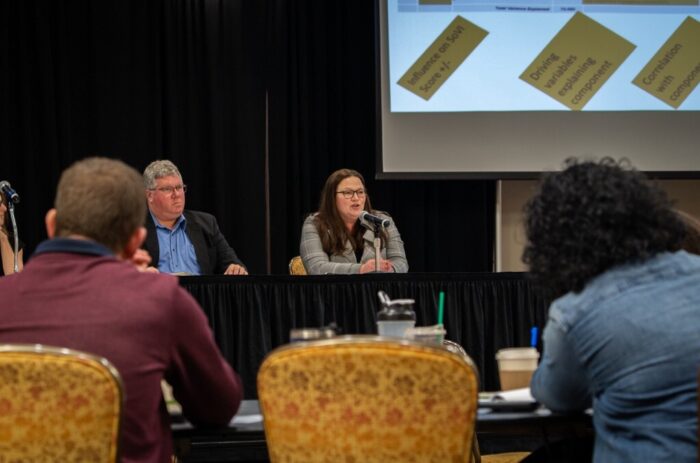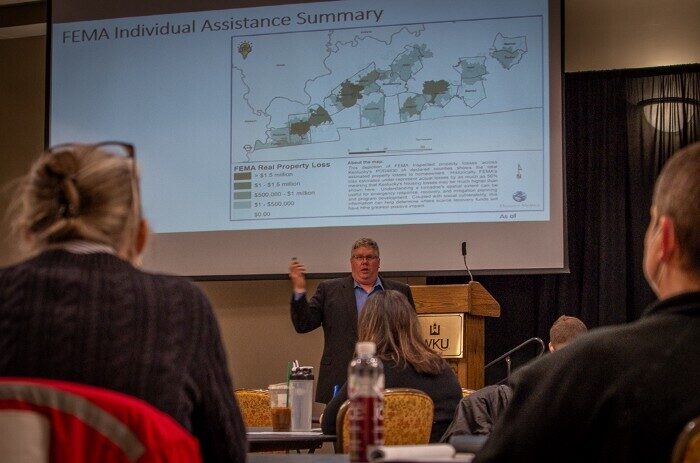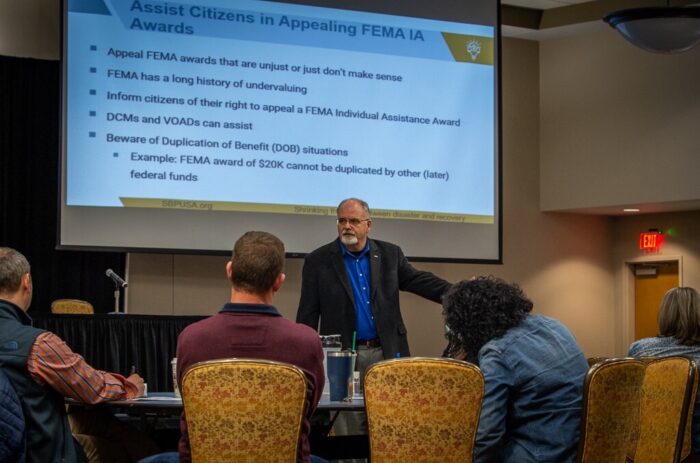After an immediate deployment in December, SBP’s team deployed again in January to tornado-impacted regions to provide recovery navigation training and develop a plan to support long-term recovery by collecting data to better understand resource gaps.
In a conference room in Bowling Green, Kentucky, where the outside temperatures were just below freezing, 40 mayors, emergency managers, exec judges, and other local leaders gathered to hear from SBP’s Government Advising team on how to navigate a path forward for their tornado-devastated communities.
Many of these civil servants haven’t had a full night’s sleep since December 11. They are fielding phone calls, emails, and in-person conversations from desperate, tired citizens trying to piece their lives back together.
Thanks to a generous partnership with Toyota, SBP brought together a panel of experts with deep wells of knowledge around recovery and federal disaster funding, having all managed it firsthand in their communities at some point in their careers.

As is true with most disasters — the leaders in the room had faced nothing like the December tornadoes before and they were not prepared for all that needed to happen next. SBP’s goal, in a few short hours, was to articulate clearly what next steps these leaders need to take — to help them access all the available resources, avoid common barriers and expedite the recovery process for their communities. They will be able to use this information to make a more successful transition from immediate response to long-term recovery.
Capturing clear and critical information about the nature and extent of damage to a community is one of the most difficult components of disaster recovery. It’s also one of the most important. Without it, it’s difficult to advocate, fundraise, or recruit resources to address enduring community needs.

Most citizens, especially the insured with savings, will recover. But those who cannot run away from disaster — the elderly on fixed incomes who aren’t insured or families living paycheck-to-paycheck who are underinsured — will have a much harder time recovering. This is why the data Dr. Chris Emrichoffered the group is especially valuable. He provided an analysis of the tornadoes’ path overlaid with Social Vulnerability Index data and as much FEMA data as he could find.

His data shows a likely FEMA under-estimation of damages to homes and businesses, as well as a low SBA application rate despite a high occurrence of affected small businesses in the area. Kentucky’s overall number of FEMA applications as of January 12 is low, and counties will need to increase these numbers as their Individual Assistance applications are directly connected to any funding their local governments receive from HUD.
Many county elected officials will struggle to capture and represent their community’s needs. For some leaders, this was the very first data they’d seen about the disaster. More is needed.
Tornado-impacted communities and those who lead them need our support. In funding, yes, but also in making sure that they are equipped with all the resources they need for an efficient and effective recovery. What SBP’s trainings aim to provide what disaster-impacted communities most need: Someone to show up and say we’re here, we’ll help and here’s what you need to do to manage this most efficiently for all your citizens.
If you want to learn more about this work, reach out to advise@sbpusa.org.

